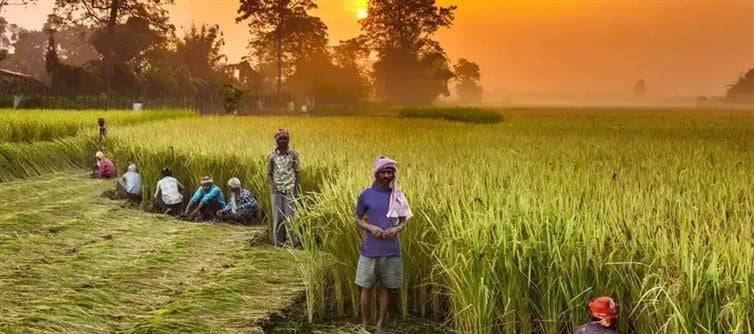
Climate change is hitting India’s farmers the hardest, with floods, droughts, pest attacks, and unseasonal weather threatening crops and livelihoods. Here’s how india can rethink agriculture for a resilient, climate-smart future:
1. Recognizing Farmers as Frontline Victims
Farmers are the first to feel the impact of erratic weather and climate disasters, facing crop losses and income instability. Protecting them is critical for food security.
2. Adopting Climate-Resilient Farming
· Use drought-tolerant and flood-resistant crop varieties
· Employ precision agriculture technologies to optimize water and fertilizer use
· Shift to crop diversification to reduce risk from extreme weather
3. Early Warning & Risk Mitigation Systems
Implement weather prediction systems, pest alerts, and disaster early warnings to help farmers take preventive action and reduce losses.
4. Financial Safety Nets
· Expand crop insurance schemes and climate risk funds
· Ensure quick compensation for crop damage due to climate events
· Provide low-interest loans for climate-adaptive farm practices
5. Sustainable Water & Soil Management
· Promote rainwater harvesting, micro-irrigation, and watershed management
· Encourage organic and regenerative farming to maintain soil health
· Reduce dependence on chemical fertilizers to protect ecosystems
6. Technology & Data-Driven Agriculture
· Leverage AI, drones, and satellite imagery for precision farming
· Use mobile apps to provide real-time crop and weather information
· Enable farmers’ access to markets and resources digitally
7. Policy & Community Support
· Strengthen government support for climate-resilient farming practices
· Build farmer cooperatives to share knowledge, resources, and technologies
· Educate communities on climate-smart practices and sustainable livelihoods
8. Building Long-Term Resilience
By combining technology, sustainable practices, financial security, and policy support, india can create a farming ecosystem that withstands climate change while ensuring farmers’ livelihoods and food security.
Disclaimer:
The views and opinions expressed in this article are those of the author and do not necessarily reflect the official policy or position of any agency, organization, employer, or company. All information provided is for general informational purposes only. While every effort has been made to ensure accuracy, we make no representations or warranties of any kind, express or implied, about the completeness, reliability, or suitability of the information contained herein. Readers are advised to verify facts and seek professional advice where necessary. Any reliance placed on such information is strictly at the reader’s own risk.
Climate change is hitting India’s farmers the hardest, with floods, droughts, pest attacks, and unseasonal weather threatening crops and livelihoods. Here’s how india can rethink agriculture for a resilient, climate-smart future:
1. Recognizing Farmers as Frontline Victims
Farmers are the first to feel the impact of erratic weather and climate disasters, facing crop losses and income instability. Protecting them is critical for food security.
2. Adopting Climate-Resilient Farming
· Use drought-tolerant and flood-resistant crop varieties
· Employ precision agriculture technologies to optimize water and fertilizer use
· Shift to crop diversification to reduce risk from extreme weather
3. Early Warning & Risk Mitigation Systems
Implement weather prediction systems, pest alerts, and disaster early warnings to help farmers take preventive action and reduce losses.
4. Financial Safety Nets
· Expand crop insurance schemes and climate risk funds
· Ensure quick compensation for crop damage due to climate events
· Provide low-interest loans for climate-adaptive farm practices
5. Sustainable Water & Soil Management
· Promote rainwater harvesting, micro-irrigation, and watershed management
· Encourage organic and regenerative farming to maintain soil health
· Reduce dependence on chemical fertilizers to protect ecosystems
6. Technology & Data-Driven Agriculture
· Leverage AI, drones, and satellite imagery for precision farming
· Use mobile apps to provide real-time crop and weather information
· Enable farmers’ access to markets and resources digitally
7. Policy & Community Support
· Strengthen government support for climate-resilient farming practices
· Build farmer cooperatives to share knowledge, resources, and technologies
· Educate communities on climate-smart practices and sustainable livelihoods
8. Building Long-Term Resilience
By combining technology, sustainable practices, financial security, and policy support, india can create a farming ecosystem that withstands climate change while ensuring farmers’ livelihoods and food security.
Disclaimer:
The views and opinions expressed in this article are those of the author and do not necessarily reflect the official policy or position of any agency, organization, employer, or company. All information provided is for general informational purposes only. While every effort has been made to ensure accuracy, we make no representations or warranties of any kind, express or implied, about the completeness, reliability, or suitability of the information contained herein. Readers are advised to verify facts and seek professional advice where necessary. Any reliance placed on such information is strictly at the reader’s own risk.




 click and follow Indiaherald WhatsApp channel
click and follow Indiaherald WhatsApp channel